Energy Production Analysis of Rooftop PV Systems Equipped with Module-Level Power Electronics under Partial Shading Conditions Based on Mixed-Effects Model
Abstract
1. Introduction
- The real-world dataset of rooftop PV systems with MLPE (DC optimizer and microinverter) includes both NSC and PSC;
- All the rooftop PV systems must be installed in the same region to neglect any difference in weather conditions affecting electrical energy production.
- Verifying the energy production benefit of a rooftop PV system with MLPE under PSC without using the irradiance data;
- Identifying the energy degradation rate of the annual energy yield, which represents the aging of PV stations, and verifying the effect of PSC on this rate.
2. Methods
2.1. PV Systems Dataset
2.2. The Applied Mixed-Effects Model
2.2.1. Average Model Based on MEM: Finding the PSC’s Effect on Energy Utilization Ratio
- The null hypothesis (): There is no significant difference in the average utilization ratio between the PSC and NSC groups. This means MLPE have improved the ability of energy harvesting in the case of PSC. If the p-value (the probability assuming that the null hypothesis is correct) is larger than , then can be assumed;
- The alternative hypothesis (): there is a significant difference in the average utilization ratio between the PSC and NSC groups ().
2.2.2. Linear Decline Model Based on MEM: Finding the PSC’s Effect on the Annual Degradation Rate
- The null hypothesis (): There is no significant difference in the trend of the annual energy yield between the PSC and NSC groups. If the p-value (the probability assuming that the null hypothesis is true) is larger than , then can be assumed;
- The alternative hypothesis (): there is a significant difference in the trend of the annual energy yield between the PSC and NSC groups ().
3. Analysis Results
3.1. The PSC’s Effect on the Energy Utilization Ratio
- The common utilization ratio of PV stations in the NSC group in Table 1 was about , and its confidence interval (CI) was from to ;
- For PV stations in the PSC group, there was a significant reduction in the utilization ratio, regardless of the types of MLPE (DC optimizer and microinverter), which was about and its (CI) was from to . In addition, the p-value of was (<), which identified the resulting value as statistically significant.
3.2. The PSC’s Effect on the Annual Degradation Rate
4. Discussion
5. Conclusions
Author Contributions
Funding
Data Availability Statement
Conflicts of Interest
Abbreviations
| LCOE | Test of variation |
| DOAJ | Levelized cost of electricity |
| MEM | Mixed-effects model |
| MLPE | Module-level power electronics |
| MPPT | Maximum power point tracking |
| NSC | Nonshading condition |
| NREL | The U.S. Department of Energy |
| PSC | Partial shading conditions |
| PV | Photovoltaic |
| Q-Q | Quantile–quantile plot |
| Nomenclature | |
| The monthly energy output of the ith PV station at the kth month of the year (kWh). | |
| The monthly referenced energy output of the ith PV station at the kth month of the year, generated via PVWatt software (kWh). | |
| The energy utilization ratio of the ith PV station at the kth month of the year. | |
| Total generated energy from a PV station on the jth day (kWh). | |
| The rated power of PV station (kW). | |
| Y | The total number of days in a year having a recorded generated energy (excluding the days for maintenance, corrupted Internet link, system errors, etc.). |
| y | The annual energy yield value of a PV station (kWh/kW). |
| The average utilization ratio of the ith PV station belong to group S. | |
| The average utilization ratio of the NSC PV group. | |
| The difference in the average utilization ratio between the PSC PV group and the NSC PV group. | |
| The residual of the utilization ratio of the ith PV station. | |
| The residual of the average utilization ratio. | |
| The baseline annual energy yield of the ith PV station. | |
| The annual degradation rate of the ith PV station. | |
| The error of the energy yield from the ith PV station. | |
| The baseline annual energy yield of all PV stations in the NSC group. | |
| The common annual degradation rate of all PV stations in the NSC group. | |
| The difference in baseline annual energy yield between the PSC PV group and the NSC PV group. | |
| The difference in common annual degradation rate between the PSC PV group and the NSC PV group. | |
| u | The residual of the baseline annual energy yield. |
| v | The residual of the annual degradation rate. |
References
- Francisco Contero, J.; Gomes, J.; Gustafsson, M.; Karlsson, B.O. The impact of shading in the performance of three different solar PV systems. In Proceedings of the 11th ISES Eurosun 2016 Conference, Palma, Spain, 11–14 October 2017; pp. 1168–1179. [Google Scholar] [CrossRef]
- Alves, T.; Torres, J.P.N.; Marques Lameirinhas, R.A.; Fernandes, C.A.F. Different Techniques to Mitigate Partial Shading in Photovoltaic Panels. Energies 2021, 14, 3863. [Google Scholar] [CrossRef]
- Toufik, S.; Ridha, K.; Abdelouahab, Z. An experimental validation of the effect of partial shade on the I-V characteristic of PV panel. Int. J. Adv. Manuf. Technol. 2018, 96, 4165–4172. [Google Scholar] [CrossRef]
- Zheng, H.; Li, S.; Proano, J. PV energy extraction characteristic study under shading conditions for different converter configurations. In Proceedings of the 2012 IEEE Power and Energy Society General Meeting, San Diego, CA, USA, 22–26 July 2012; pp. 1–8. [Google Scholar]
- Gallardo-Saavedra, S.; Karlsson, B. Simulation, validation and analysis of shading effects on a PV system. Sol. Energy 2018, 170, 828–839. [Google Scholar] [CrossRef]
- Galtieri, J.; Krein, P.T. Energy improvements from subpanel DC-DC converters in PV arrays with distributed mismatch. In Proceedings of the 2016 IEEE 43rd Photovoltaic Specialists Conference (PVSC), Portland, OR, USA, 5–10 June 2016; pp. 3213–3218. [Google Scholar]
- Sarwar, S.; Javed, M.Y.; Jaffery, M.H.; Ashraf, M.S.; Naveed, M.T.; Hafeez, M.A. Modular Level Power Electronics (MLPE) Based Distributed PV System for Partial Shaded Conditions. Energies 2022, 15, 4797. [Google Scholar] [CrossRef]
- Nafeh, A.E.S.A. Novel Maximum-Power-Point Tracking Algorithm For Grid-Connected Photovoltaic System. Int. J. Green Energy 2010, 7, 600–614. [Google Scholar] [CrossRef]
- Birane, M.; Larbes, C.; Cheknane, A. Comparative study and performance evaluation of central and distributed topologies of photovoltaic system. Int. J. Hydrogen Energy 2017, 42, 8703–8711. [Google Scholar] [CrossRef]
- SolarEdge Power Optimizer. Available online: https://www.solaredge.com/products/power-optimizer/ (accessed on 20 November 2022).
- Enphase Microinverter. Available online: https://enphase.com/en-us/products-and-services/microinverters (accessed on 20 November 2022).
- Deline, C.; Meydbray, J.; Donovan, M. Photovoltaic Shading Testbed for Module-Level Power Electronics: 2016 Performance Data Update; Technical Report Contract No. DE-AC36-08GO28308; NREL National Renewable Energy Laboratory: Golden, CO, USA, 2016.
- Deline, C.; Marion, B.; Granata, J.; Gonzalez, S. A Performance and Economic Analysis of Distributed Power Electronics in Photovoltaic Systems; Technical Report Contract No. DE-AC36-08GO28308; NREL National Renewable Energy Laboratory: Golden, CO, USA, 2011. [Google Scholar]
- Sinapis, K.; Litjens, G.; van den Donker, M.; Folkerts, W.; van Sark, W. Outdoor characterization and comparison of string and MLPE under clear and partially shaded conditions. Energy Sci. Eng. 2015, 3, 510–519. [Google Scholar] [CrossRef]
- Tsafarakis, O.; Sinapis, K.; van Sark, W.G.J.H.M. A Time-Series Data Analysis Methodology for Effective Monitoring of Partially Shaded Photovoltaic Systems. Energies 2019, 12, 1722. [Google Scholar] [CrossRef]
- Hernández-Callejo, L.; Gallardo-Saavedra, S.; Diez-Cercadillo, A.; Gómez, V.A. Analysis of the influence of DC optimizers on photovoltaic production. Rev. Fac. Ingeniería Univ. Antioq. 2020, 94, 43–55. [Google Scholar] [CrossRef]
- Mehedi, I.; Salam, Z.; Ramli, M.; Chin, V.; Bassi, H.; Rawa, M.; Abdullah, M. Critical evaluation and review of partial shading mitigation methods for grid-connected PV system using hardware solutions: The module-level and array-level approaches. Renew. Sustain. Energy Rev. 2021, 146, 111138. [Google Scholar] [CrossRef]
- Wang, Q.; Le, L.; Li, D.; Ai, X.; Fang, J.; Yao, W.; Wen, J. Modeling and Energy Generation Evaluations of Large-Scale Photovoltaic Plants Equipped With Panel-Level DC Optimizers. Front. Energy Res. 2022, 10, 30. [Google Scholar] [CrossRef]
- Hanson, A.J.; Deline, C.A.; MacAlpine, S.M.; Stauth, J.T.; Sullivan, C.R. Partial-Shading Assessment of Photovoltaic Installations via Module-Level Monitoring. IEEE J. Photovolt. 2014, 4, 1618–1624. [Google Scholar] [CrossRef]
- IEC TS 61724-3:2016; Photovoltaic System Performance-Part 3: Energy Evaluation Method. Available online: https://webstore.iec.ch/publication/25466 (accessed on 20 November 2022).
- Roach, C. Estimating electricity impact profiles for building characteristics using smart meter data and mixed models. Energy Build. 2020, 211, 109686. [Google Scholar] [CrossRef]
- Simões, P.F.M.; Souza, R.C.; Calili, R.F.; Pessanha, J.F.M. Analysis and short-term predictions of non-technical loss of electric power based on mixed effects models. Socio-Econ. Plan. Sci. 2020, 71, 100804. [Google Scholar] [CrossRef]
- Haynes, W. Student’s t-Test. In Encyclopedia of Systems Biology; Dubitzky, W., Wolkenhauer, O., Cho, K.H., Yokota, H., Eds.; Springer: New York, NY, USA, 2013; pp. 2023–2025. [Google Scholar] [CrossRef]
- ANOVA Method For Comparison Models. Available online: https://www.rdocumentation.org/packages/ltm/versions/1.1-1/topics/anova (accessed on 20 November 2022).
- PVOutput Dataset. Available online: https://pvoutput.org/ (accessed on 20 November 2022).
- PVWatts Calculator. Available online: https://pvwatts.nrel.gov/pvwatts.php (accessed on 20 November 2022).
- Le, N.T.; Benjapolakul, W. Comparative Electrical Energy Yield Performance of Micro-Inverter PV Systems Using a Machine Learning Approach Based on a Mixed-Effect Model of Real Datasets. IEEE Access 2019, 7, 175126–175134. [Google Scholar] [CrossRef]
- Le, N.T.; Asdornwised, W.; Chaitusaney, S.; Benjapolakul, W. Application of The Mixed Effects Model for Analyzing Photovoltaic Datasets and Interpreting Into Meaningful Insights. IET Gener. Transm. Distrib. 2021, 15, 2101–2111. [Google Scholar] [CrossRef]
- Pinheiro, J.C.; Bates, D.M. Mixed-Effects Models in S and S-PLUS. In Statistics and Computing; Springer: New York, NY, USA, 2000. [Google Scholar] [CrossRef]
- Garcia, T.P.; Ma, Y.; Marder, K.; Wang, Y. Robust mixed effects model for clustered failure time data: Application to Huntington’s disease event measures. Ann. Appl. Stat. 2017, 11, 1085–1116. [Google Scholar] [CrossRef] [PubMed]
- Schielzeth, H.; Dingemanse, N.J.; Nakagawa, S.; Westneat, D.F.; Allegue, H.; Teplitsky, C.; Réale, D.; Dochtermann, N.A.; Garamszegi, L.Z.; Araya-Ajoy, Y.G. Robustness of linear mixed-effects models to violations of distributional assumptions. Methods Ecol. Evol. 2020, 11, 1141–1152. [Google Scholar] [CrossRef]
- Warrington, N.M.; Tilling, K.; Howe, L.D.; Paternoster, L.; Pennell, C.E.; Wu, Y.Y.; Briollais, L. Robustness of the linear mixed effects model to error distribution assumptions and the consequences for genome-wide association studies. Stat. Appl. Genet. Mol. Biol. 2014, 13, 567–587. [Google Scholar] [CrossRef]
- The R-Project for Statistical Computing. Available online: https://cran.r-project.org/bin/windows/base/ (accessed on 20 November 2022).
- Pinheiro, J.; Bates, D.; DebRoy, S.; Sarkar, D.; R Core Team. Nlme: Linear and Nonlinear Mixed Effects Models; CRAN: Chicago, IL, USA, 2018. [Google Scholar]
- Simple Levelized Cost of Energy (LCOE) Calculator Documentation. Available online: https://www.nrel.gov/analysis/tech-lcoe-documentation.html (accessed on 20 November 2022).
- Lai, C.S.; McCulloch, M.D. Levelized cost of electricity for solar photovoltaic and electrical energy storage. Appl. Energy 2017, 190, 191–203. [Google Scholar] [CrossRef]
- Mundada, A.S.; Shah, K.K.; Pearce, J. Levelized cost of electricity for solar photovoltaic, battery and cogen hybrid systems. Renew. Sustain. Energy Rev. 2016, 57, 692–703. [Google Scholar] [CrossRef]
- Kang, M.H.; Rohatgi, A. Quantitative analysis of the levelized cost of electricity of commercial scale photovoltaics systems in the US. Sol. Energy Mater. Sol. Cells 2016, 154, 71–77. [Google Scholar] [CrossRef]

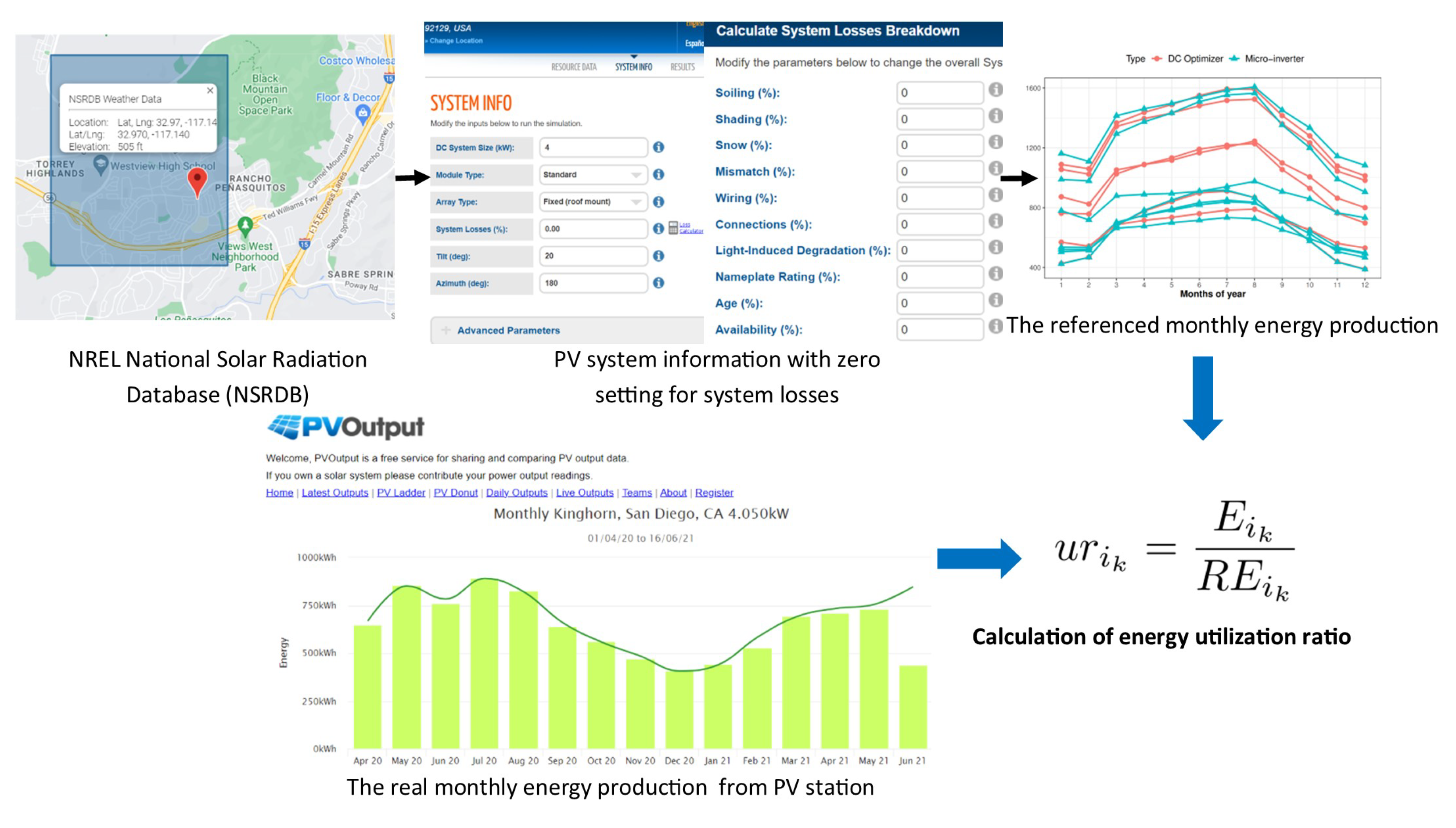
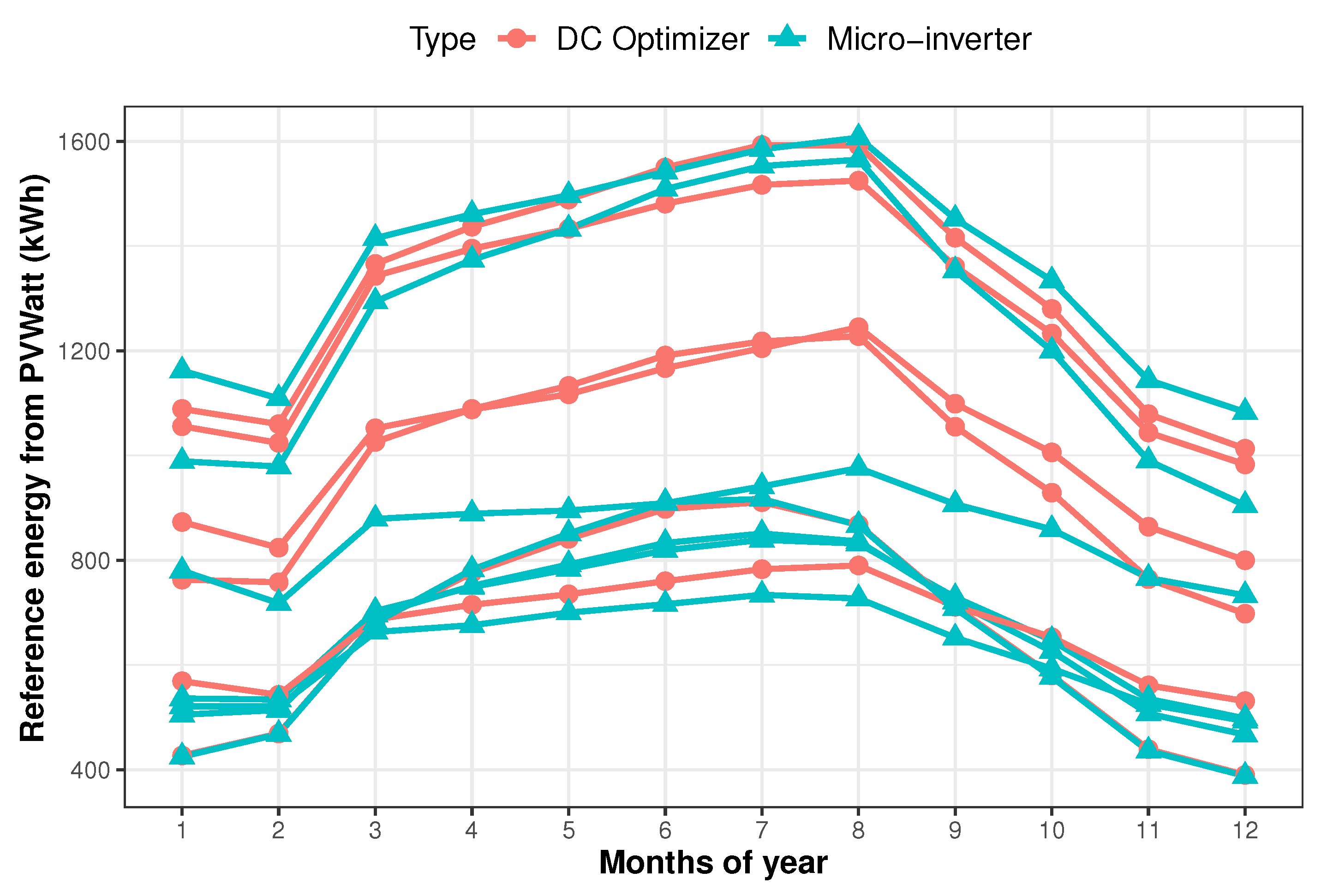
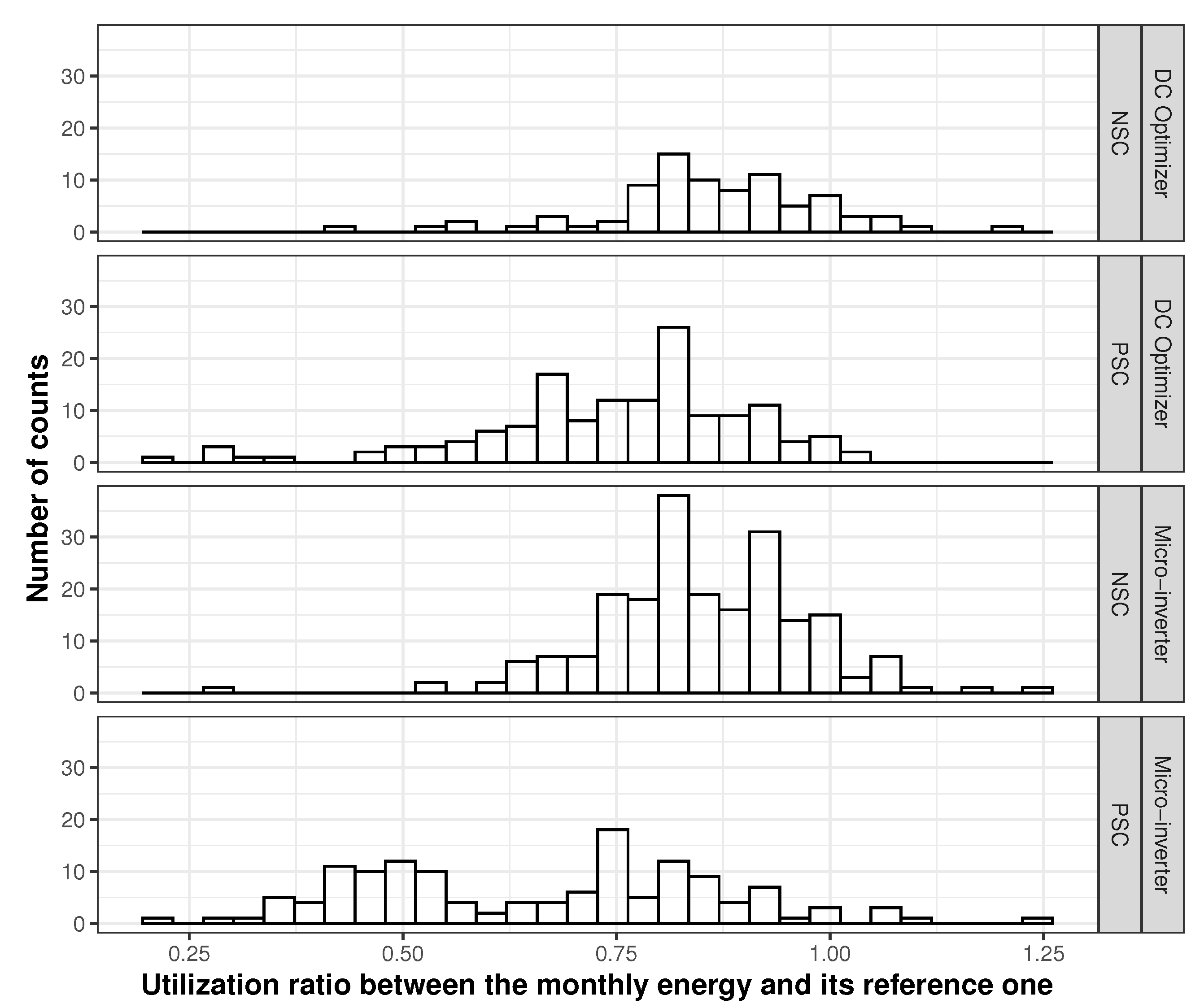
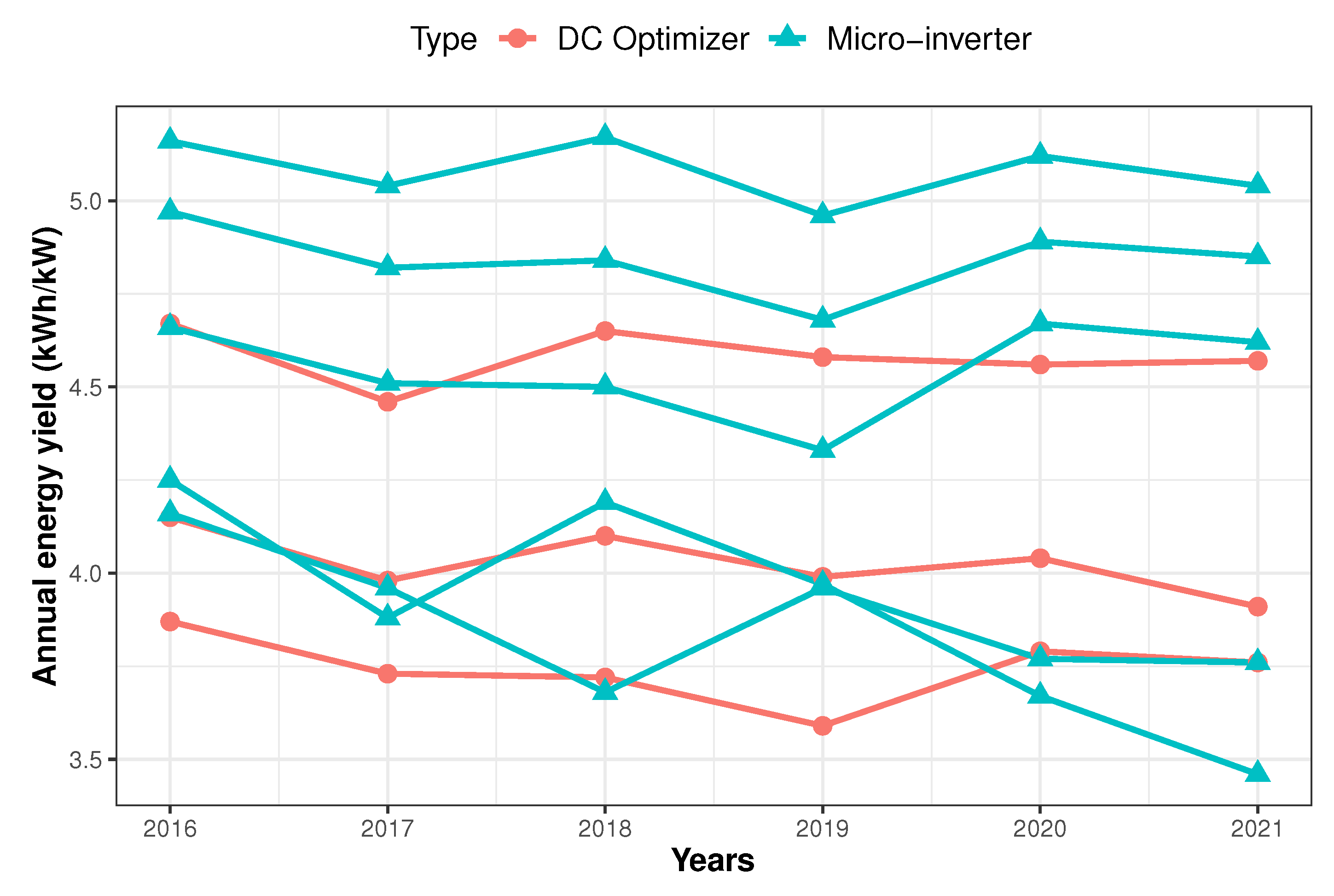
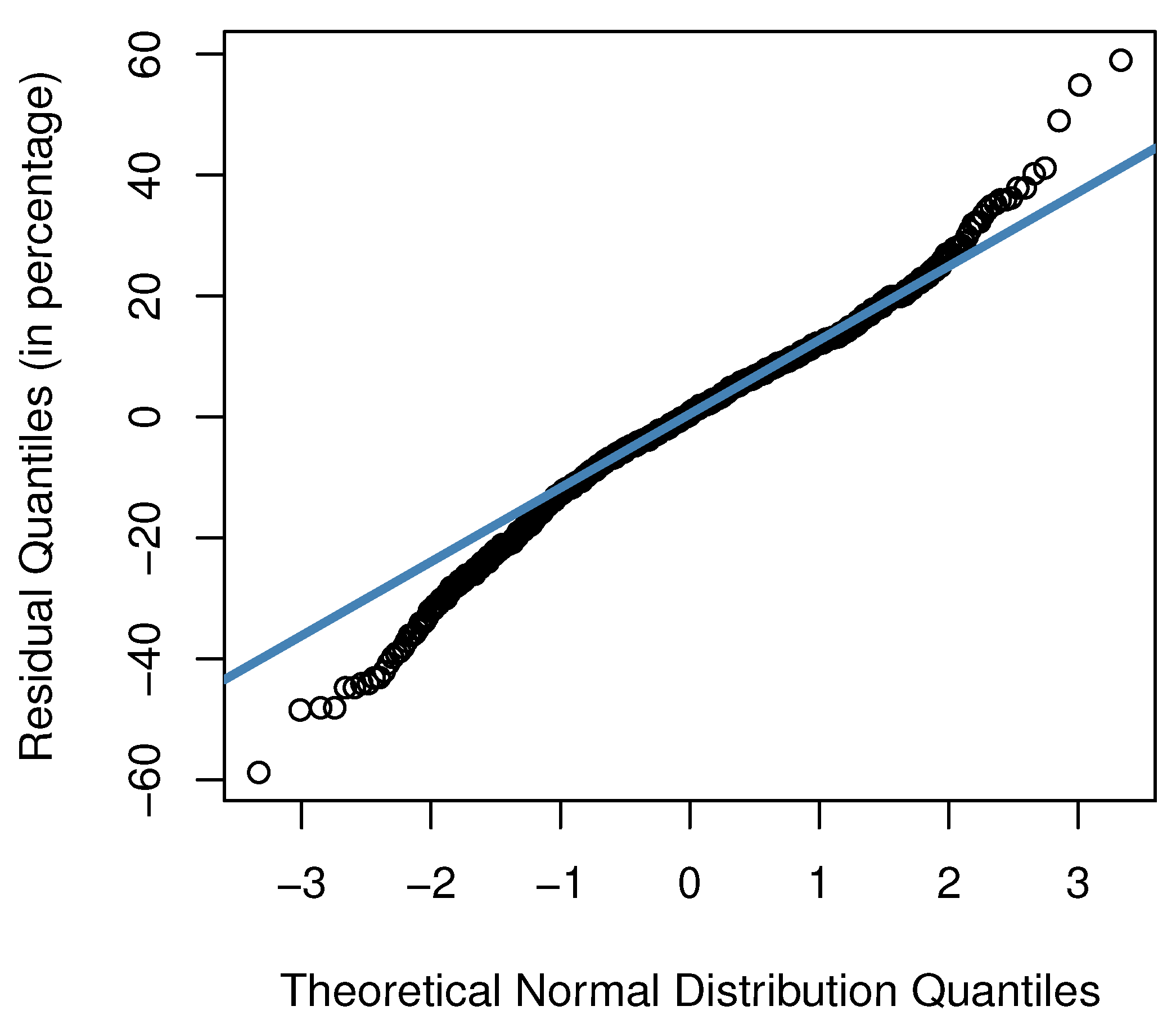
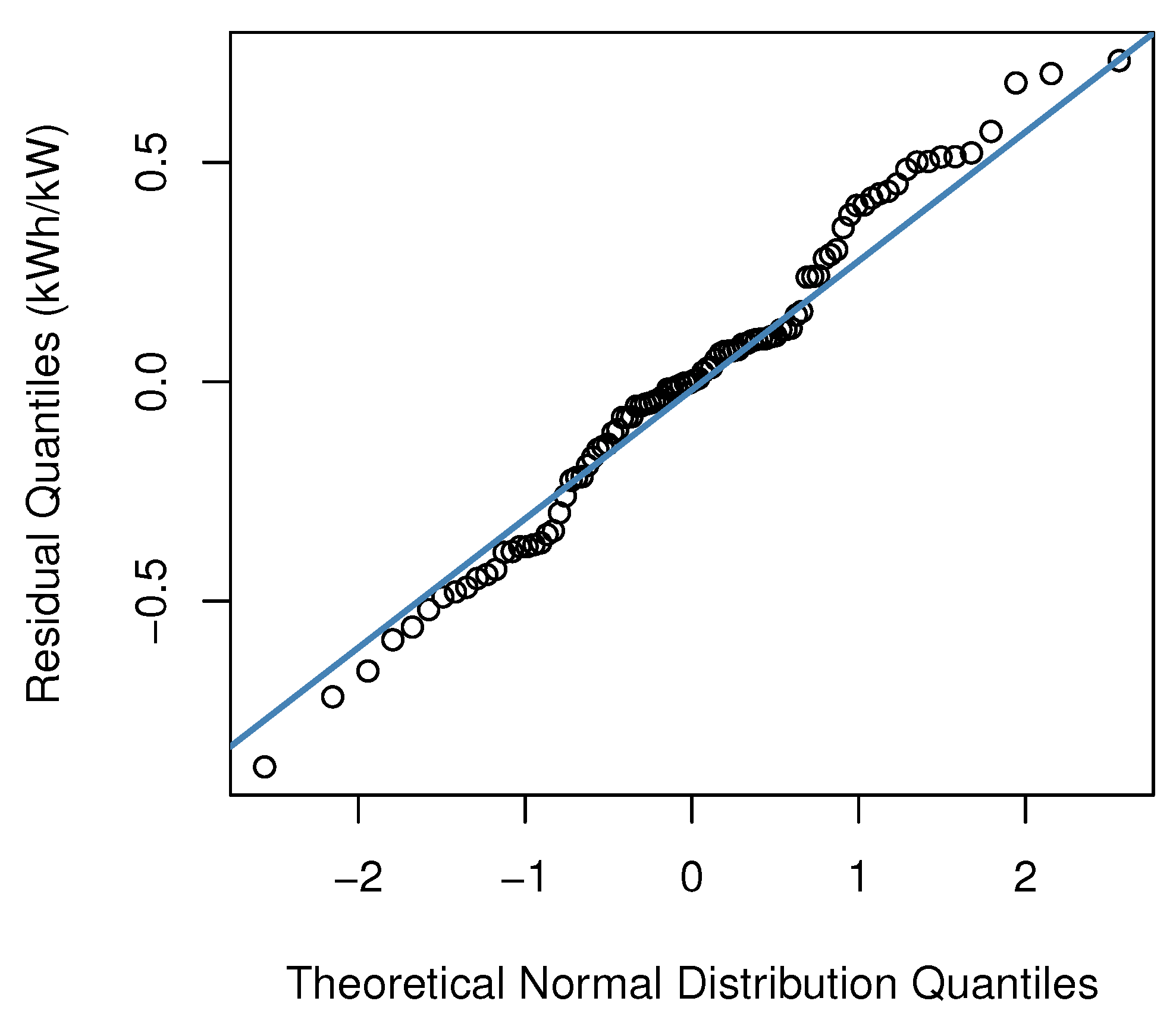
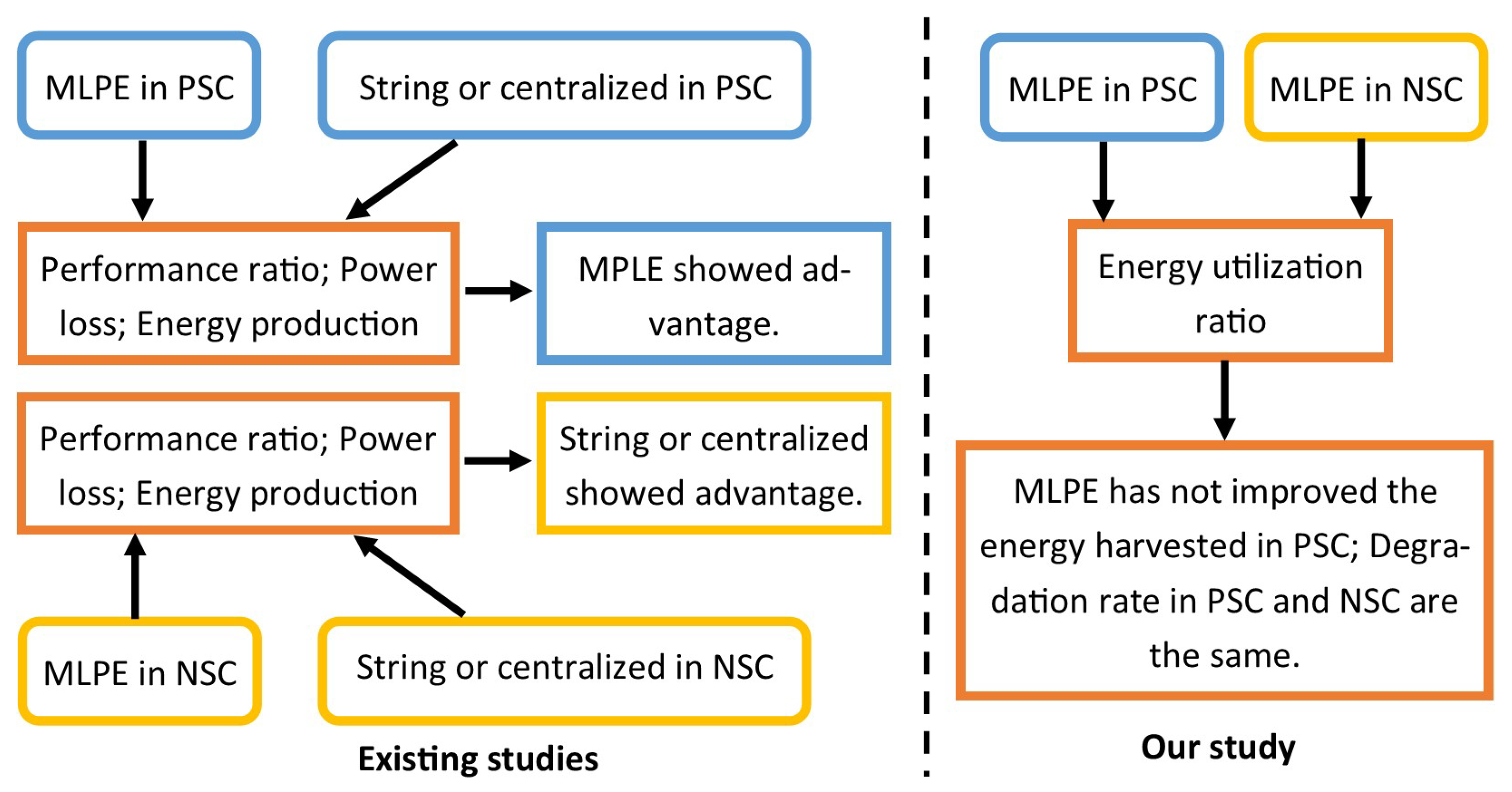
| Name | Installed Power (kW) | MPPT Method | PV Array | Inverter Configuration | Orientation | PSC | Tilt Degrees | ||
|---|---|---|---|---|---|---|---|---|---|
| Rated Power (W) | Total Panel | Rated Power (W) | Number of Inverters | ||||||
| Kinghorn | 4.05 | DC optimizer | 270 | 15 | 3800 | 1 | South | Yes | 23 |
| Barrymore plant | 4.48 | DC optimizer | 280 | 16 | 6000 | 1 | South west | No | 1 |
| IIIudium Q-36 | 6.36 | DC optimizer | 335 | 19 | 7600 | 1 | South west | Yes | 37 |
| Torrey Santa Fe | 8.12 | DC optimizer | 290 | 28 | 7600 | 1 | South | No | 19 |
| RP SolarSetup | 6.03 | DC optimizer | 335 | 18 | 7600 | 1 | South West | No | 23 |
| 24 LG 320SolarEdge | 7.68 | DC optimizer | 320 | 24 | 7600 | 1 | South | Yes | 21 |
| Across the park | 4.23 | Microinverter | 235 | 12 | 190 | 12 | South | No | 15 |
| Justpluggedin | 7.8 | Microinverter | 260 | 30 | 250 | 30 | South west | No | 23 |
| Koobzilla | 3.84 | Microinverter | 240 | 16 | 215 | 16 | South | No | 22 |
| Solar Bob | 5.13 | Microinverter | 270 | 19 | 250 | 19 | South | No | 33 |
| JCG’s Almazon System | 4.25 | Microinverter | 250 | 17 | 215 | 17 | South | Yes | 11 |
| ZzPV | 8.16 | Microinverter | 285 | 28 | 250 | 28 | South | Yes | 24 |
| Rhubottom Envoy System | 4.46 | Microinverter | 235 | 19 | 215 | 19 | South west | Yes | 1 |
| Name | Installed Power (kW) | MPPT Method | PV Array | Inverter Configuration | Orientation | PSC | Tilt Degrees | ||
|---|---|---|---|---|---|---|---|---|---|
| Rated Power (W) | Total Panel | Rated Power (W) | Number of Inverters | ||||||
| Kinghorn | 4.05 | DC optimizer | 270 | 15 | 3800 | 1 | South | Yes | 23 |
| Barrymore plant | 4.48 | DC optimizer | 280 | 16 | 6000 | 1 | South west | No | 1 |
| IIIudium Q-36 | 6.36 | DC optimizer | 335 | 19 | 7600 | 1 | South west | Yes | 37 |
| Across the park | 4.23 | Microinverter | 235 | 12 | 190 | 12 | South | No | 15 |
| Koobzilla | 3.84 | Microinverter | 240 | 16 | 215 | 16 | South | No | 22 |
| Solar Bob | 5.13 | Microinverter | 270 | 19 | 250 | 19 | South | No | 33 |
| JCG’s Almazon System | 4.25 | Microinverter | 250 | 17 | 215 | 17 | South | Yes | 11 |
| ZzPV | 8.16 | Microinverter | 285 | 28 | 250 | 28 | South | Yes | 24 |
| Fixed Effects | Meaning | Value (%) | 95% CI | p Value | Mean Square Error (MSE) |
|---|---|---|---|---|---|
| The common utilization ratio of PV stations in NSC group | ( to ) | <0.0001 | |||
| The difference of utilization ratio between PSC and NSC groups | ( to ) |
| Random Effects | Source of Variance | Variance | R-Squared |
|---|---|---|---|
| Variance among PV stations in two groups | |||
| Residuals (errors) from each PV station |
| ANOVA Test | Source of Variation | Degrees of Freedom | Sum of Square | Mean Square | F-Test | p Value |
|---|---|---|---|---|---|---|
| Effect of PSC | Between two PV groups | 1 | 30970 | 30970 | 125.8 | <0.0001 |
| Within a PV group | 575 | 141581 | 246.2 |
| Parameter | Meaning | Value (kWh/kW) | 95% CI (kWh/kW) | p Value |
|---|---|---|---|---|
| Baseline energy yield of NSC group | ( to ) | <0.0001 | ||
| Degradation rate of NSC group | ( to ) | |||
| Difference in baseline energy yield between PSC and NSC groups | ( to ) | |||
| Difference in degradation rate between PSC and NSC groups | ( to () |
| Parameter | Source of Variance | Variance | R-Squared |
|---|---|---|---|
| Baseline energy yield | |||
| Degradation rate | |||
| Residuals |
Disclaimer/Publisher’s Note: The statements, opinions and data contained in all publications are solely those of the individual author(s) and contributor(s) and not of MDPI and/or the editor(s). MDPI and/or the editor(s) disclaim responsibility for any injury to people or property resulting from any ideas, methods, instructions or products referred to in the content. |
© 2023 by the authors. Licensee MDPI, Basel, Switzerland. This article is an open access article distributed under the terms and conditions of the Creative Commons Attribution (CC BY) license (https://creativecommons.org/licenses/by/4.0/).
Share and Cite
Le, N.T.; Truong, T.L.; Asdornwised, W.; Chaitusaney, S.; Benjapolakul, W. Energy Production Analysis of Rooftop PV Systems Equipped with Module-Level Power Electronics under Partial Shading Conditions Based on Mixed-Effects Model. Energies 2023, 16, 970. https://doi.org/10.3390/en16020970
Le NT, Truong TL, Asdornwised W, Chaitusaney S, Benjapolakul W. Energy Production Analysis of Rooftop PV Systems Equipped with Module-Level Power Electronics under Partial Shading Conditions Based on Mixed-Effects Model. Energies. 2023; 16(2):970. https://doi.org/10.3390/en16020970
Chicago/Turabian StyleLe, Ngoc Thien, Thanh Le Truong, Widhyakorn Asdornwised, Surachai Chaitusaney, and Watit Benjapolakul. 2023. "Energy Production Analysis of Rooftop PV Systems Equipped with Module-Level Power Electronics under Partial Shading Conditions Based on Mixed-Effects Model" Energies 16, no. 2: 970. https://doi.org/10.3390/en16020970
APA StyleLe, N. T., Truong, T. L., Asdornwised, W., Chaitusaney, S., & Benjapolakul, W. (2023). Energy Production Analysis of Rooftop PV Systems Equipped with Module-Level Power Electronics under Partial Shading Conditions Based on Mixed-Effects Model. Energies, 16(2), 970. https://doi.org/10.3390/en16020970






